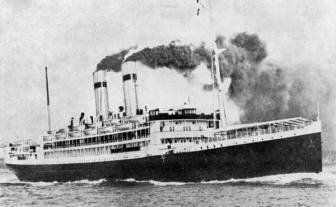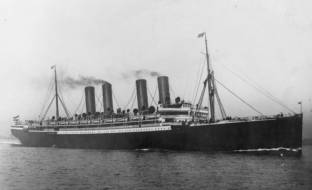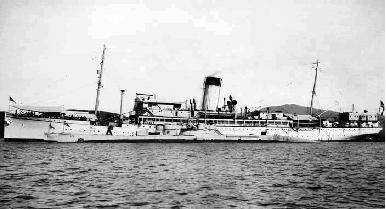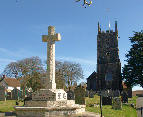The Roll of Honour records E H Isaac, Royal Navy Air Service. However, a suitable E H Isaac has not been found and the Navy Service Records only contain Ernest John Isaac, who probably transfered into the Royal Navy Air Service just after the war. As this was about the time Col. Alexander was compiling his proposed list for inclusion on the Roll of Honour, and as Ernest John was closely associated with Winkleigh through both his mother and father, it has been assumed that there is an incorrect initial on the Roll.
Ernest John Isaac was born on 24th May 1884 and his father was William Isaac. Although William was born in Wembworthy, his mother and most of his siblings were born in Winkleigh. Isaac has been a common name in Winkleigh and has included Moses Isaac who was a brass founder and moved on to mechanical engineering with his son. Ernest’s mother was Mary Jane Curtis who had come from Northlew near Okehampton to work in Winkleigh. After a possibly hurried marriage, Ernest was born in Crediton. William and his growing family moved quite often, but always near other Isaacs. It seems that the Isaacs were a very close extended family and possibly helped to get work places for William. In later years, William’s mother and father moved to the same locations as William. It is possible that William moved back to Winkleigh after his parents died. However, Ernest was to be one of a few Winkleigh young men who joined the Royal Navy as a career before the first World War. He joined so early that it was before his fourth sister Elsie was born, which brought the number of children up to seven. As a result Ernest saw the transition from sail to steam and from wooden ships to iron, as well as many other innovations such as increasing firepower.
Ernest joined the Navy as soon as possible when he was 15 and was assigned to HMS Impregnable on 14 September 1899 as a Boy Cadet class 2c. The Impregnable had originally been named HMS Howe, designed as a 121 gun ship with the first screw propulsion. However, she was never completed for sea service because she was already made obsolete by the first ironclad warships, and never carried more than 12 guns. Five days after Ernest joined Impregnable, he was joined by John Henry Bartlett another new Boy Cadet from Tideford Cornwall just a year older than Ernest. Within the next three days it is reported that Ernest saved John H Bartlett from drowning. On the 22nd John was transferred to the HMS Lion, a cruiser being used for training. A month later John was discharged from the Navy as an invalid. On 31st May 1900 Ernest was promoted to Boy class 1c and on 31st January 1901, he joined HMS Agincourt which was an ironclad frigate, a fully rigged ship with a steam engine. The Agincourt had had a good service history, being the flagship to fifteen admirals. Now she was a training ship off Portland.
After only two and a half months, Ernest was transferred to HMS Howe, were he is recorded in he 1901 census off Portland. The Howe was the last of the Admiralty-class battleships, completed in 1885 and commissioned in 1889. Despite many developments during the seven years of her building, none of these improvements were incorporated, so she was not the ultimate ship that had been expected when she had been ordered. The Howe spent most of her time in the Mediterranean, where the most notable event was grounding on Ferrol Rock. She was freed with great difficulty and repaired and overhauled at Chatham. In 1901 she was relegated to the Royal Navy Reserve. On 13th October 1901, Ernest transferred again; this time to HMS Empress of India which was a pre-dreadnought battleship of the Royal Sovereign class, perhaps the best all-round battleships in the world in the early 1890s when they were completed. Ernest joined her when she had been re-commissioned and was departing to relieve battleship HMS Howe at Queenstown, Ireland, as both port guard ship and flagship of the Senior Naval Officer Coast of Ireland. Ernest was only with her for a month and a half before returning to Devonport for a couple of weeks further shore training which was probably in preparation for Ernest to become a Seaman.
After this training, Ernest was assigned to HMS Pearl on 17 December 1901 and would stay with her for three years. The Pearl was a cruiser built in Pembroke in 1889, 265 feet long with a top speed of 17 knots and a complement of 217 men, and its armament consisted of 8 x 4.7 inch and 8 x 3lb guns. The Pearl had been on a year’s refit in Devonport and was now preparing to sail to South Africa. On 17 Dec 1901 she was commissioned by Captain E P Ashe for the Cape of Good Hope and West Africa station. On 17th April the Pearl moved to Simonstown from where she supported operations during the Boer War until the end of May, escorting transports and landing parties of men at Port Nolloth and Lamberts Bay to assist in unloading and guarding transports. Although Ernest did not go ashore, he was awarded the Queen’s South Africa Medal, along with 14 men from the ship who did go ashore and received the medal with bars. Ernest’s medal was issued to HMS Pearl in April 1902. On his eighteenth birthday in May, Ernest was eligible to become an Ordinary Seaman which he did on that day when he signed on for twelve years. On 12th December 1902 he became an Able Seaman and remained on the Pearl until she was paid off at Simonstown and Ernest went to join HMS Simoom on 30th November 1904.
The Simoom had previously been named HMS Monarch, an iron screw ship launched in 1868 and converted to a guardship in 1897. She had been active at the bombardment of Alexandria in 1882 firing 125 12-inch (300 mm) shells at the Egyptian forts. She was now past her prime and had been used as a depot ship and now returned and was waiting to be sold. On 15 February 1905, Ernest started further training at Devonport in preparation for gunnery training aboard HMS Cambridge (formally HMS Windsor Castle) moored at Devonport. Ernest spent three months on HMS Cambridge on which most of the guns were 32 pounders although there were thirty 8 inch guns and a few others. The guns were actually fired towards the land at canvas targets mounted on poles stuck into the sand. Ernest then spent two and a half months on HMS Victorious before she was paid off at the end of 1906. The Victorious, launched in 1895, was the largest battleship ever built at the time, but had not yet been converted from coal to oil fired propulsion. Another month training at Dartmouth and Ernest was assigned to HMS Repulse for two years.
HMS Repulse was one of the most potent battleships when she was completed in 1894, but had recently been made obsolete when HMS Dreadnought appeared in 1906. The Repulse was 410 feet long with a maximum cruising speed of 17 knots with two coal fired engines and a complement of 712 men. Her armament included four 13.5 inch guns and 32 smaller calibre guns with 6 torpedo tubes. When Ernest joined her in February 1907, the Repulse had come to Devonport to serve as a special service vessel for the next three years. However, Ernest was to leave her in January 1909 when he was assigned to HMS Hawke a protected cruiser for two months before transferring to HMS Nightingale for a year.
HMS Nightingale was a gunboat launched in 1897 and served on the Yangtze river in China. After his year on the Nightingale, Ernest spent a couple of months on HMS Edgar, a cruiser launched at Devonport Dockyard in 1890, before spending nine months at Vivid 1, one of the shore establishments at Devonport. On 1st February 1911, Ernest was assigned to HMS Bellerophon for two years. HMS Bellerophon was a dreadnought completed in 1909 and was the most expensive ship of her class at £1,763,491. She was 526 feet long with ten 12 inch and 16 4 inch guns together with four 3 pounder guns and 3 torpedoes, with a complement of 733 officers and men. The Bellerophon had 4 steam turbine coal fired engines which gave her top speed about 21 knots, slightly less than her sister ships which had more power. During the time Ernest was aboard Bellerophon was with the 1st Battle Squadron of the Home Fleet. However, on 26 May 1911 she was in collision with HMS Inflexible which suffered bow damage and was in dock until November.
On 1st April 1913, Ernest went back to Devonport for a month and a half before being assigned to the Mersey class second class cruiser HMS Forth for a year. These cruisers were considered to be handy ships, steady gun platforms and good sea boats, but Forth was now a depot ship. In May 1914, Ernest returned to the Devonport shore establishment because his 12 year contract was complete and he had requested to leave the Navy. This may have been because he had not been promoted above Able Seaman although his reports had been consistently “Very Good” throughout his service, or because of the talk of impending war and he felt it wise to leave. Ernest left the Navy on 30 May 1914 and thus joined the Royal Fleet Reserve. What Ernest most probably did not know was that plans were being prepared to send all ships to sea in case if or when war was declared.  As a result, Ernest was recalled to join the Royal Navy because those in the Royal Fleet Reserve could be recalled in the event of a national emergency, and he found himself on board the protected cruiser HMS Highflyer on 2 August 1914, just two months after leaving. Two days later, he set sail on the cruiser from Plymouth together with HMS Vindictive on the day war was declared with Germany. The two ships then captured the liner Tubantia, which was carrying German reservists and gold. Highflyer escorted her to Britain, before returning to her station.
As a result, Ernest was recalled to join the Royal Navy because those in the Royal Fleet Reserve could be recalled in the event of a national emergency, and he found himself on board the protected cruiser HMS Highflyer on 2 August 1914, just two months after leaving. Two days later, he set sail on the cruiser from Plymouth together with HMS Vindictive on the day war was declared with Germany. The two ships then captured the liner Tubantia, which was carrying German reservists and gold. Highflyer escorted her to Britain, before returning to her station.
Shortly after, HMS Highflyer was transferred to the Cape Verde station to support the 5th Cruiser Squadron in the hunt for the German commerce raider SS Kaiser Wilhelm der Grosse. This ship was originally a passenger liner, built in 1897, a part of the German merchant fleet, until requisitioned for service at the outbreak of World War I and fitted with six 4-inch guns and two 37-millimeter guns. The battle off Rio de Oro on 26 August 1914 began when the German raider SS Kaiser Wilhelm der Grosse was caught by surprise in a harbour, taking on coal from three German and Austrian colliers.  Rio de Oro was in Spanish Sahara, which is now Western Sahara. Highflyer, which greatly outgunned the German auxiliary cruiser with eleven 6-inch guns, nine 12-pounder guns, six 3-pounder guns and two torpedo tubes, first demanded surrender but the German commander argued that the British had violated Spain’s neutrality. The British disregarded this because the Germans had already violated Spain’s neutrality by taking over a week to resupply in a neutral port. So a battle began, from 3:10 pm to 4:45 pm the two ships bombarded each other, sometimes dodging the shots. Eventually Kaiser Wilhelm der Grosse exhausted her ammunition and began to flee the battle. Now out of ammunition, running from several larger guns, the crew scuttled their ship and abandoned her to the Atlantic. The German sailors made it to shore and escaped into the Saharan Desert. Kaiser Wilhelm der Grosse became the first passenger liner to sink during World War I. One Briton was killed and six others wounded. German casualties are unknown. At the end of September, Ernest was transferred to HMS Edinburgh Castle which was an auxiliary cruiser for the Atlantic patrol from Devonport until January 1915, when Ernest had a further period at Devonport.
Rio de Oro was in Spanish Sahara, which is now Western Sahara. Highflyer, which greatly outgunned the German auxiliary cruiser with eleven 6-inch guns, nine 12-pounder guns, six 3-pounder guns and two torpedo tubes, first demanded surrender but the German commander argued that the British had violated Spain’s neutrality. The British disregarded this because the Germans had already violated Spain’s neutrality by taking over a week to resupply in a neutral port. So a battle began, from 3:10 pm to 4:45 pm the two ships bombarded each other, sometimes dodging the shots. Eventually Kaiser Wilhelm der Grosse exhausted her ammunition and began to flee the battle. Now out of ammunition, running from several larger guns, the crew scuttled their ship and abandoned her to the Atlantic. The German sailors made it to shore and escaped into the Saharan Desert. Kaiser Wilhelm der Grosse became the first passenger liner to sink during World War I. One Briton was killed and six others wounded. German casualties are unknown. At the end of September, Ernest was transferred to HMS Edinburgh Castle which was an auxiliary cruiser for the Atlantic patrol from Devonport until January 1915, when Ernest had a further period at Devonport.
On 1st April 1915 Ernest had his final assignment to HMS Warspite. Interestingly, Richard George Mitchell also from Winkleigh and on the Roll of Honour joined the Warspite on the same day. Warspite was a Queen Elizabeth-class battleship which served in both world wars and earned the most battle honours ever awarded to an individual ship in the Royal Navy, including the most awarded for actions in the Second World War. She was commissioned 8 March 1915, being 639ft 5in long with a design speed of 24 knots and impressive armament that was changed from time to time. During the gunnery trials Churchill was present when she fired her 15in guns and was suitably impressed with their accuracy and power. When Ernest was assigned to her, she was joining the 2nd Battle Squadron of the Grand Fleet. Late that year, Warspite was grounded in the River Forth causing some damage to her hull; she had been led by her escorting destroyers down the small ships channel. After repairs, she rejoined the Grand Fleet, this time as part of the newly formed 5th Battle Squadron which had been created for Queen Elizabeth class ships. In early December, Warspite was involved in another incident when, during an exercise, she collided with her sister-ship Barham, which caused considerable damage to Warspite.
Between 31 May and 1 June 1916, Warspite fought with the squadron in the Battle of Jutland - the largest encounter between Britain and Germany during the war, and the biggest naval battle ever. The German Navy, which had been blockaded with other shipping, decided to lure the Home Fleet to Jutland with the objective of destroying a large proportion of the fleet. Thus the German fleet started to amass off Jutland but the Home Fleet arrived a little sooner than expected and attacked immediately on arrival on 31st May 1916. Warspite sustained fifteen hits, incurring such considerable damage that she almost foundered. Her steering jammed while attempting to avoid her sister-ship Valiant. Warspite’s captain decided to maintain course, in effect circling, rather than come to a halt and reverse. This decision exposed Warspite. The manoeuvres made Warspite a tempting target and inadvertently diverted attention from the badly-damaged cruiser, Warrior. This gained her the admiration of Warrior’s crew, who believed Warspite’s movement had been intentional.
The crew regained control of Warspite after two full circles. Their efforts to end the circular motion had the consequence of placing her on a course towards the German fleet. The rangefinders and the transmission station were non-functional and only “A” turret could fire, albeit under local control with 12 salvos falling short of their target. Sub Lieutenant Herbert Annesley Packer was promoted and mentioned in dispatches for his command of “A” turret. Due to her condition, Warspite was ordered to halt and make necessary repairs. Warspite would be plagued with steering irregularities for the rest of her service life.
During the battle, Warspite had 14 killed and 16 wounded; among the latter warrant officer Walter Yeo, who became one of the first men to receive facial reconstruction via plastic surgery. Although extensively damaged, Warspite could still sail under her own volition, and was ordered home by Rear-Admiral Hugh Evan-Thomas, commander of the 5th Battle Squadron. While on her journey to Rosyth, Warspite came under attack from a German U-boat. The U-boat fired three torpedoes, all of which missed their target. Warspite later attempted to ram a surfaced U-boat. She reached Rosyth, where her damage was repaired, and upon the completion of her repairs, Warspite rejoined the 5th Battle Squadron. Further misfortune struck soon afterwards, when she again collided with a sister-ship, this time Valiant. The incident necessitated repairs. In June 1917, Warspite collided with HMS Destroyer. In the following month, Warspite was rocked at her moorings in Scapa Flow when Vanguard, a St Vincent-class battleship, exploded with the loss of hundreds of her crew when an ammunition magazine detonated. In 1918, Warspite had to be repaired after a boiler room caught fire. On 21 November, Warspite, under the command of Hubert Lynes, set sail to receive the German High Seas Fleet into internment at Scapa Flow following the signing of the Armistice.
In 1919, Warspite joined the 2nd Battle Squadron, part of the newly-formed Atlantic Fleet. She served in the Mediterranean for the majority of her assignment to the fleet. It was in September 1919 that Ernest decided to continue serving in the Navy after the war. His hair was now described as black, his complexion fresh and he had acquired the tattoo “Dancing Girl” on his left arm. It was about this time that a catapult and spotter plane were being added to Warpite. This may be the reason that Ernest is listed in the Royal Naval Air Service, if he had been assigned to working with this equipment, because it is about the time that Col. Alexander was preparing his draft list for the Roll of Honour. However, he still had not been promoted above Able Seaman and at the end of 1920 he was passed as educationally fit for the rank of Petty Officer. Consequently he was promoted to Leading Seaman on 6 January 1921. It was just four weeks later that he was transferred back to the administrative establishment at Devonport. It appears that Ernest, despite his continuous Very Good reports, did not have the leadership or other characteristics considered essential for promotion. HMS Warpite went on to serve in World War Two and saw much action for which she got many battle honours. Despite proposals to save her as a museum, the Admiralty decided to scrap her in 1947. However, during the tow to the scrap yard she was hit by a severe storm and was driven aground near Cudden Point. She refloated herself but went hard aground at nearby Prussia Cove and was partially scrapped there. In 1950 and using compressed air to float her, she was dragged off the rocks and beached off St Michael’s Mount in August. After further salvage, more attempts were made to move her In November, but they only managed 130 feet nearer the shore. In the summer of 1955 she disappeared from view.
 From Devonport, Ernest was assigned to HMS Ambrose, a submarine depot ship, on 8th October 1921. Ernest was with the Ambose for just over a year before being assigned to HMS Vindictive on 7th December 1922. HMS Vindictive was intended as a heavy cruiser but during her construction was converted to carry aircraft which were hoisted up from the hangar to a small flight deck. Completed in 1918 she was soon renamed Vindictive. These modifications made her lighter than intended which now gave her a top speed on 29 knots. However, by the end of 1911 and the arrival of dedicated aircraft carriers, Vindictive was redundant but was to have other roles throughout the years until finally scrapped in 1946.
From Devonport, Ernest was assigned to HMS Ambrose, a submarine depot ship, on 8th October 1921. Ernest was with the Ambose for just over a year before being assigned to HMS Vindictive on 7th December 1922. HMS Vindictive was intended as a heavy cruiser but during her construction was converted to carry aircraft which were hoisted up from the hangar to a small flight deck. Completed in 1918 she was soon renamed Vindictive. These modifications made her lighter than intended which now gave her a top speed on 29 knots. However, by the end of 1911 and the arrival of dedicated aircraft carriers, Vindictive was redundant but was to have other roles throughout the years until finally scrapped in 1946.
Ernest stayed with the Vindictive for less than two months after he joined her. After a few days back at Devonport, he left the Royal Navy on 23rd February 1923 with his pension and transferred as was normal back to the Royal Fleet Reserve coming up to his 40th birthday. We do not what became of Ernest, but we assume that as he was unlikely to progress further in the Navy and life was not the same as being on an active warship like the Warspite, he decided he would be better doing something else.
9 November 2012


